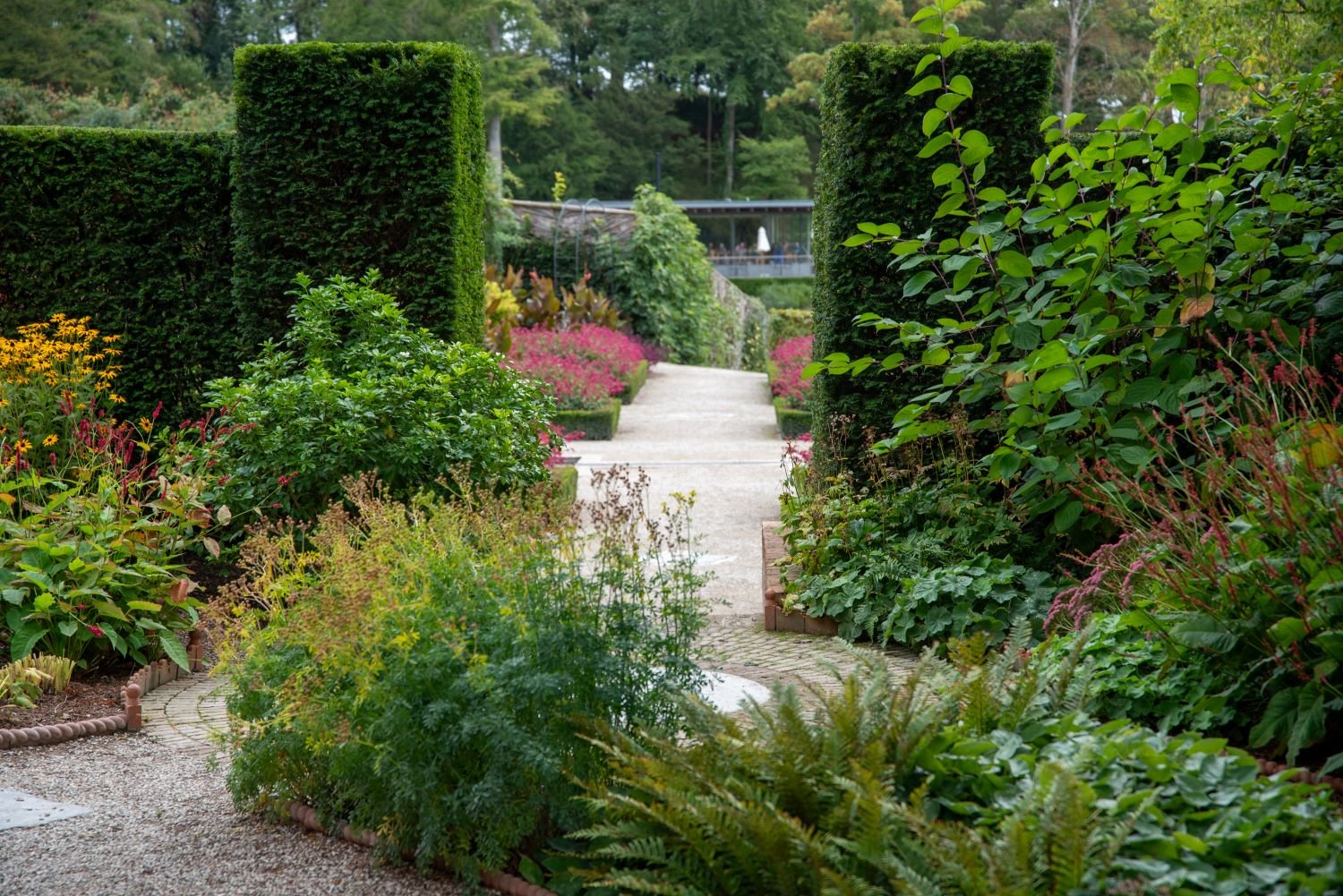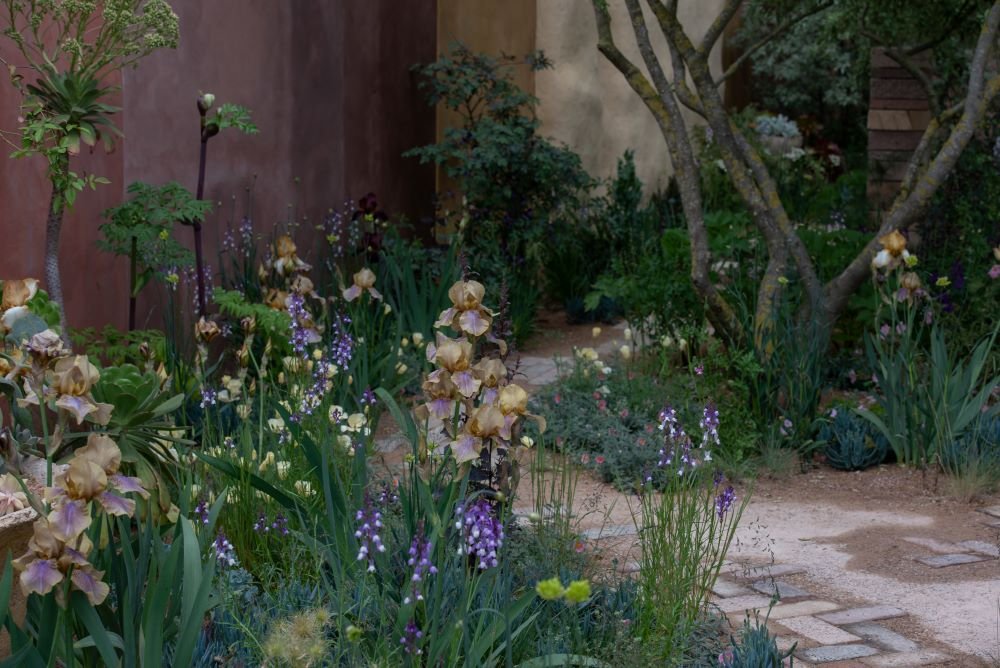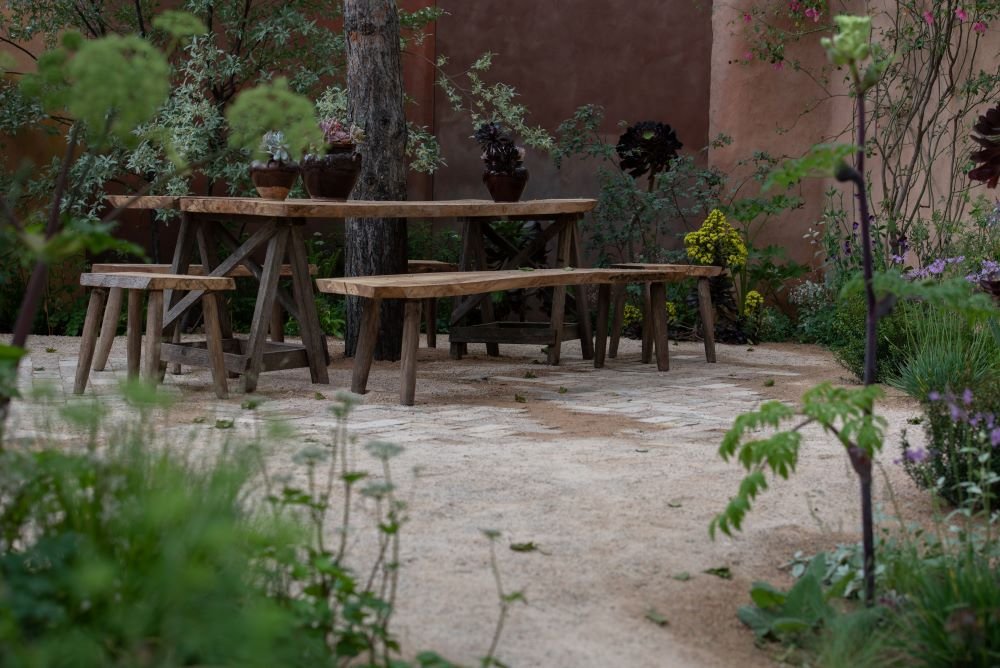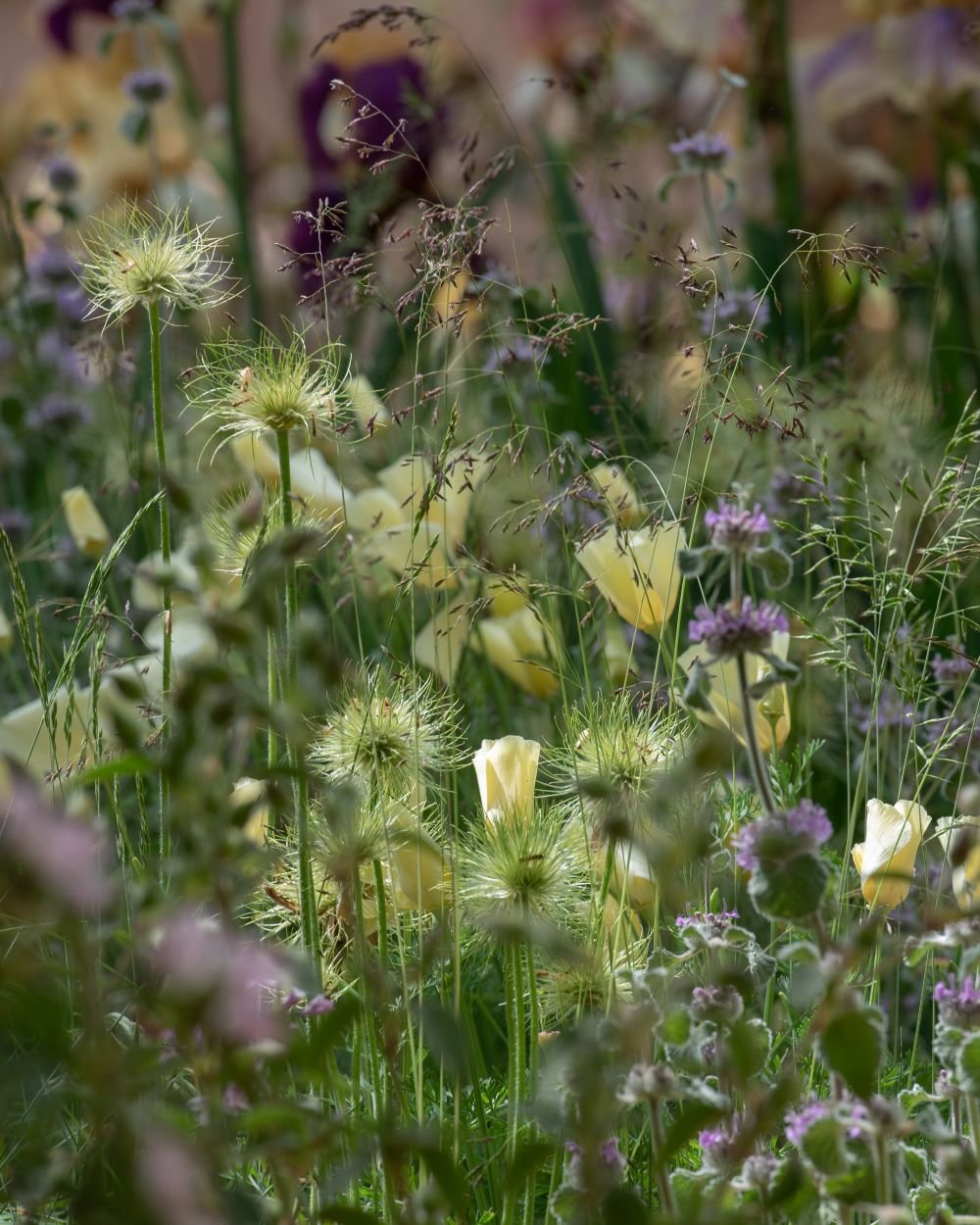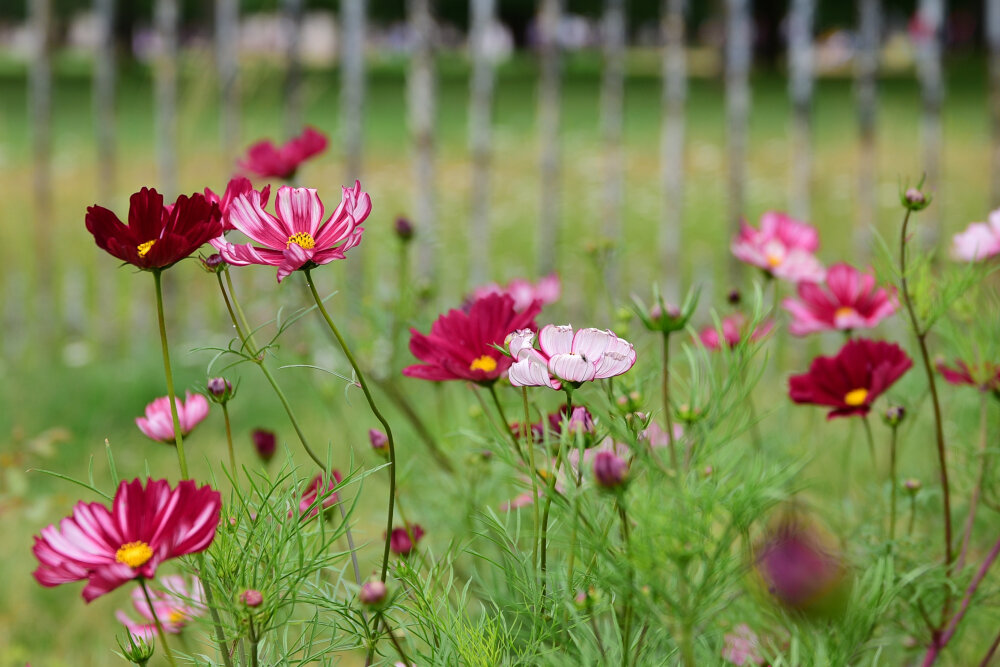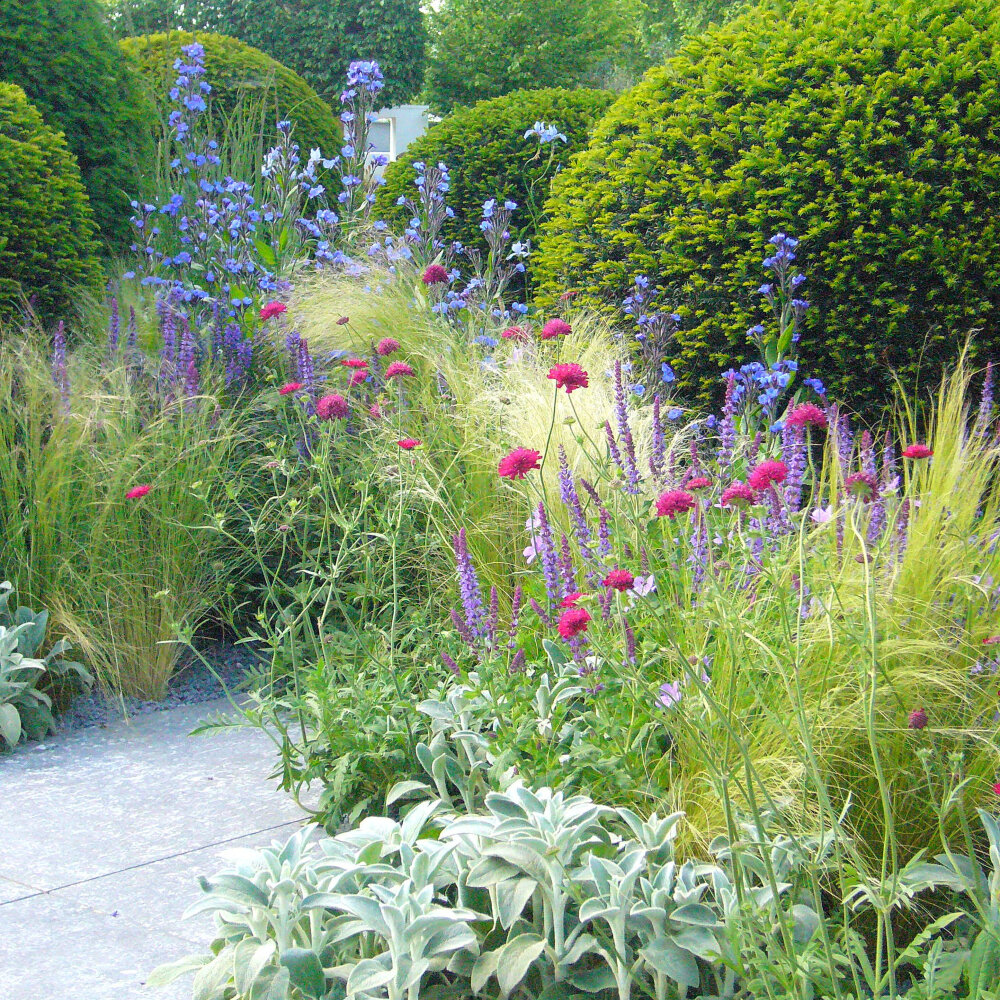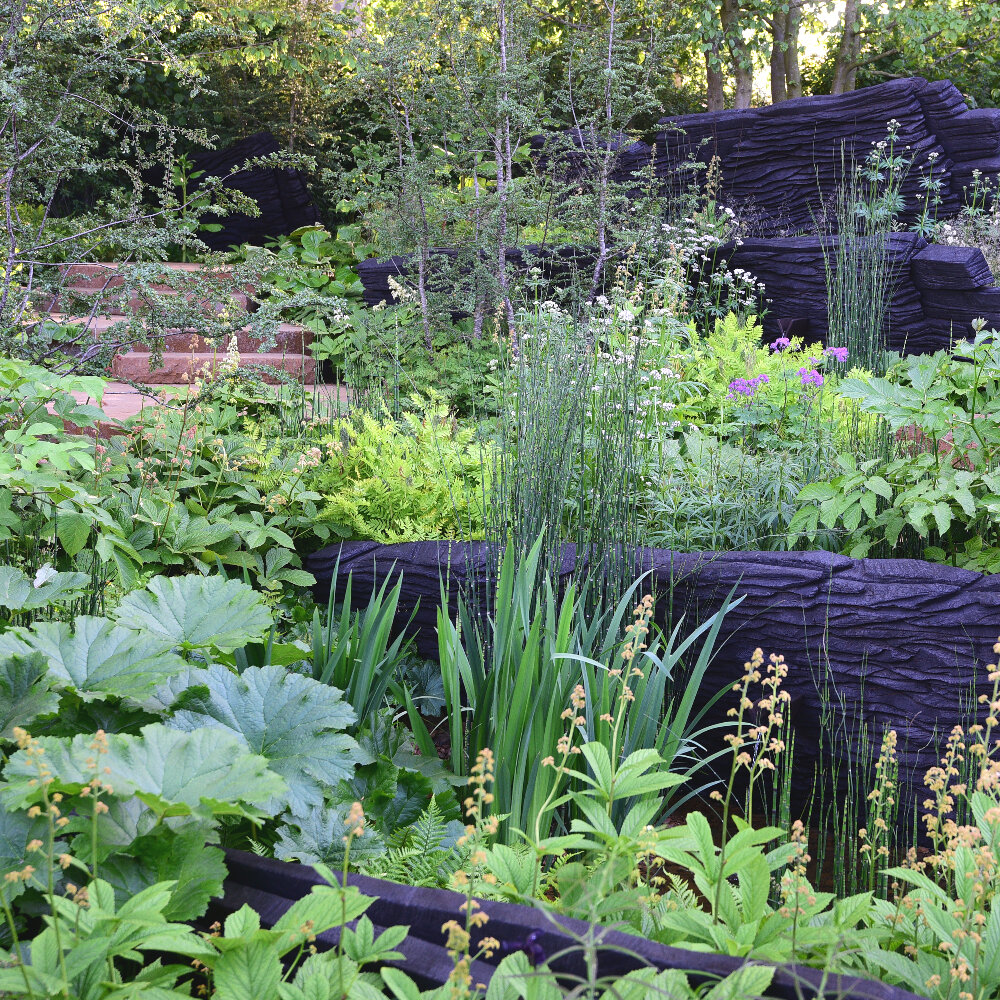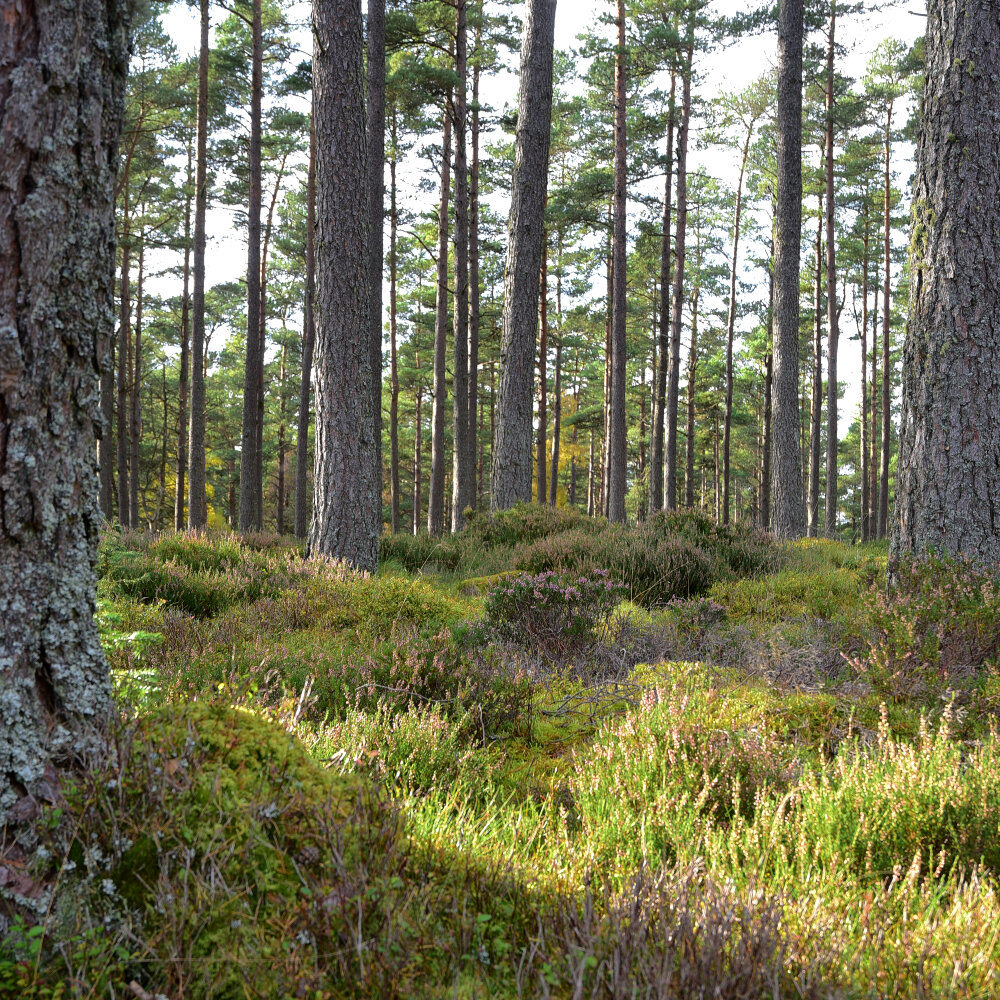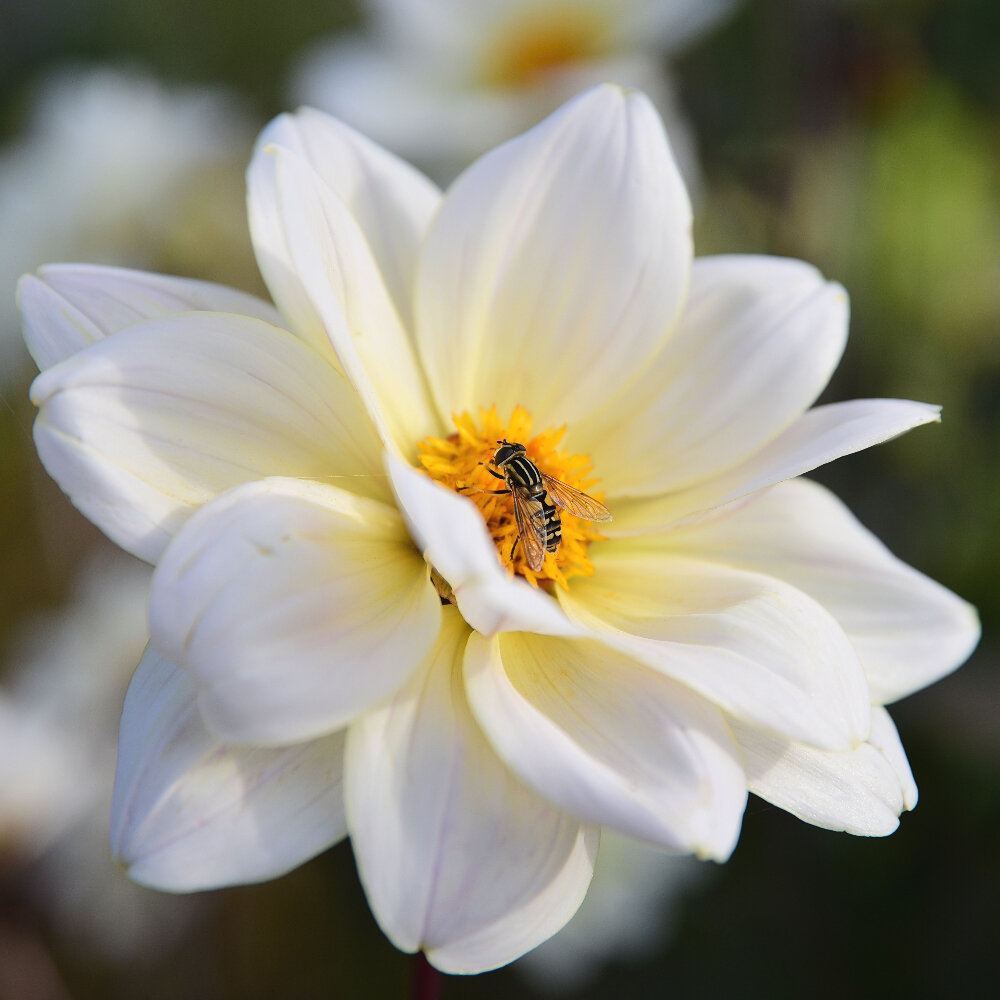Project Giving Back - Chelsea 2024
In any other year a damp, grey day at the Chelsea Flower Show would have been unusual, not in 2024 though. Whilst most humans aren’t that happy in the rain, gardens absolutely love it. Colours are more vibrant and plants look much fresher.
The Octavia Hill Garden by Blue Diamond with the National Trust
In recent years there have been far fewer large show gardens on the main avenue, and now all are sponsored by charities rather than big corporates. This is in no small part as a result of Project Giving Back.
The WaterAid Garden
“Project Giving Back is the vision of two private individuals who want to support a wide range of charitable causes whose work suffered during the global Covid-19 pandemic and continues to be affected by the economic downturn and cost-of-living crisis.
World Child Cancer’s Nurturing Garden
The grant-making scheme gives UK-based charities and other charitable organisations the chance to apply for a fully-funded garden at the RHS Chelsea Flower Show, subject to the usual RHS selection process. This is a unique opportunity for charities to raise awareness of and support for their work at the world’s most famous horticultural event.”
Muscular Dystrophy Garden
The first Chelsea Flower Show to benefit was in 2022, and 12 gardens were supported. The most well-known of these was the best in show garden by Lulu Urquart and Adam Guinness - remember the controversial re-wilded garden for beavers?
The National Garden Scheme Garden
Most of the plants from this garden (there wasn’t a lot of hard landscaping) went to the Lindengate garden in Wendover, Buckinghamshire. This mental health charity uses its six acre garden to provide social and therapeutic horticulture to people of all ages.
Terrence Higgins Trust Bridge to 2030
A further 15 gardens were supported in 2023, including another best in show winner, Horatio’s Garden, designed by Charlotte Harris and Hugo Bugg.
St James’s Picadilly: Imagine the world to be different
Horatio’s Garden is a charity set up to provide gardens for people with spinal injuries and the show garden has gone to the Princess Royal Spinal Cord Injuries Centre in Sheffield, opening later this year.
The Anywhere Courtyard
In 2024 another 15 gardens were supported, including yet another best in show garden, the Muscular Dystrophy forest bathing garden designed by Ula Maria. This garden will be relocated to The Prince & Princess of Wales Hospice in Glasgow.
mgr Changing Tides Garden
It’s quite a complicated process moving a show garden to its final home. Inevitably there is an element of redesign to fit the new space and in the meantime both the hard landscaping materials and plants may have to be stored before they can be re-used. Some new elements may be incorporated as Chelsea Show gardens are for May, not really for 12 months of the year.
Stroke Association’s Garden for Recovery
Project Giving Back is scheduled to continue for a further two years. It’s a good fit with the RHS’s ethos of sustainability and trying to keep the Chelsea Flower Show as green as possible.
Sue Ryder Grief Kind Garden
Project Giving Back also provides support for garden designers, helping those with a good idea find a charitable partner to link up with, and it also helps newer designers get into Chelsea for the first time.
Bowel Research UK Microbiome Garden
All good things usually come to an end though, so how will the RHS find sponsors with pockets deep enough for a £250,000 show garden once Project Giving Back ends after 2026?
2023, a year in photos
I googled “what will 2023 be famous for?” There were some forecasts - war, climate catastrophe, financial turbulence and technological change - so far, so predictable. But a fashion trend for blackened teeth thankfully hasn’t come to pass (or did I miss it?).
Wimbledon Common in January
The year started with a famously cold January. It was a near record of eight days in a row of freezing temperatures. Whilst Wimbledon Common looked fab in the heavy frost the weather took its toll in the garden. Many people lost plants, in particular Hebes, Erigeron karvinskianus and Penstemons. They were hard to replace initially as the frost had affected so many gardens as well as suppliers in the UK and Europe.
Cyclamen at Wakehurst Place in February
One answer to this is to plant a winter garden, full of plants that look their best at this time of year. I went to visit Wakehurst Place which has a fairly new winter garden. It didn’t disappoint and partly as a response to this we have developed a couple of winter borders in my local park.
Magnificent magnolia in Bushy Park in March
A persistent easterly wind in March and April meant that spring felt like a long time coming but finally, after a few false starts, I got on a plane for the first time in three years to go to the garden island of Madeira.
Fanal Forest, Madeira, in April
There were gardens aplenty on the island but one of the most fascinating sights was the ancient laurel forest on the north slope. Subject to frequent fog and mist the trees were already mature when the Spanish arrived in the 14th century. It is an eerie place and, as I found, it’s very easy to get lost.
Bluebells in the Surrey Hills in May
May was a busy month. The weather warmed up a little and I found a great new bluebell wood in the Surrey Hills. The sun also came out for the Chelsea Flower Show and there was only one garden everyone was talking about - Sarah Price’s iris garden. It wasn’t overrated, almost worth the ticket price on its own.
Chelsea Flower Show in May
Also in May I finished planting a new garden in Wimbledon. Throughout the year I have continued as a volunteer gardener in my local park. Luckily the summer wasn’t quite as scorching as 2022. The ox-eye daisies in a wildflower part of the park were stunning in June.
Ox-eye daisies in June
All through 2023 I have been learning how to use a 3D design software package. It has been challenging to say the least but considerable progress has been made. I’m not sure I’ll ever reach guru status, but it’s good to get to a stage where clients can see their prospective gardens in 3D and even walk through them. I haven’t had a client yet say they prefer the old hand-drawn way of doing things.
Cedar greenhouse in July
In July I caught up with a friend who I’d helped with the layout of her garden ahead of the installation of a new greenhouse.
Waterperry Gardens in August
In August there was an overload of garden visits to Ham House, Waterperry Gardens and the best garden I’ve seen in a long time, Le Jardin Plume.
Le Jardin Plume, Normandy in August
Whilst in France I also visited the garden festival at Chaumont and the formal gardens at Chenonceau.
Chenonceau in September
Autumn took a long time to arrive, an unexpected heatwave followed by what seemed like endless rain, and then finally, some spectacular colour. Piet Oudolf describes a fifth season, somewhere between summer and autumn. The garden at the Hepworth Wakefield is a great example of how good a garden can look at this inbetween time.
Allium sphareocephalon and Perovskia in October
And my photographic year ends there, somewhat abruptly. The big camera is out of action and the camera on my phone doesn’t really cut it as a replacement. Normal service will be resumed shortly, hopefully in time for some winter photography.
Gifts for gardeners
It’s back, the only reasonably sensible list for gardeners of all types, no cashmere pyjamas or pink suede gauntlets here…
These are two of my favourite coffee table purchases of the year. I enjoyed my visit to Le Jardin Plume so much I bought the book. Yes it is in French but you don’t need to be fluent to get the gist of what’s going on. The photos tell the story, and the photos are fab.
I’ve been going to Kew Gardens since I was knee high to a grasshopper but only went into the Marianne North Gallery for the first time earlier this year. All of the 627 paintings - part botanical illustration, part travelogue - are reproduced here. Marianne North visited 13 countries and four continents in the second half of the 19th century and she paid for the construction of the gallery to house all her paintings. A major vanity project? And so what.
Sarah Price’s garden at the 2023 Chelsea Flower Show
Well no list is complete without a ticket to the Chelsea Flower Show. Is it expensive, is it over crowded, is it worth it? Hell yeah. The RHS runs one or two other shows which are all a bit cheaper, a bit less less busy and, well, you get what you pay for….
Looking for an easy way to boost your garden’s attractiveness to wildlife? Just add water. Birds, insects and mammals will all find a small pond very appealing. It doesn’t have to be deep, or have a fountain or even require digging a big hole.
A shallow water bowl or bird bath will do the job. A few pebbles and a couple of plants will finish it off nicely.
West Green House gardens and caff
Who doesn’t enjoy a nice garden visit with a fabulous lunch thrown in? Top of my list is Gravetye Manor (still waiting..), The Newt was fab and the cafe at West Green is a little more modest but no less tasty.
The restaurant at The Newt
Most gardeners are suckers for tools, especially really good quality ones. I’ve mentioned Felco secateurs before, as well as Showa 370 gardening gloves, Silky Fox folding saws, Hayter lawnmowers and Henchmen ladders.
Fab even when not in use
And they also love seed trays, garden twine, small terracotta pots, compost (but so awkward to wrap…), magazine subscriptions, bird boxes, seeds and cake of course.
Cedar greenhouse
But nothing says I love you like a bespoke cedar greenhouse…
And finally, what not to buy a gardener unless they have specifically asked for it - a plant. You have no idea how difficult it is to accommodate a rose that’s the wrong colour, or an inappropriately sized tree, into a carefully curated garden.
Chelsea 2023 - Sarah Price's Garden
It’s not often a show garden at Chelsea is universally popular. Despite being heavily featured on the tv coverage there were still gasps of delight and audible wows as visitors saw it for the first time.
And I think this is the first time I’ve showcased a single Chelsea garden, that’s how much I liked it.
Iris Benton Susan
The most striking thing about the garden when you see it for the first time is the amazing display of Benton irises. Cedric Morris was an artist and also bred irises ast his Suffolk home, Benton End. “Cedric Morris was famous for his flower paintings and iris still lifes. You can see that he really understood the plants, but he was also an incredible gardener, who influenced Beth Chatto. He introduced 90 different cultivars of bearded iris,” says Sarah.
Iris Benton Olive and Aeonium Zwartkopf
The irises, like the garden at Benton End, languished for many years. A former head gardener at Sissinghurst, Sarah Cook, began the long process of hunting them down and breeding them, a process which is now carried on by others.
Like all the gardens this one has had to prove its environmental credentials and the builders claim it has the lowest carbon footprint of any garden at the show. All the materials are found and/or recycled and much of the garden will be relocated back to Benton End at the end of the show.
Rosa x odora mutabilis
This garden is about much more than the irises however, It is also an evocation of the old garden at Benton End. Other plants such as the trees and grasses are designed to appear semi-wild. The colour palette of pink, blue and yellow is taken from two of Cedric Morris’s paintings (Cotyledon and Eggs, and The Eggs).
A couple of things really appealed to me: the overall colour palette which is muted but has depth too, and changes colour in different light; and the overall feeling of light and space. The only other garden which had this quality was the Transcendence garden by Andrew Wilson and Gareth McWilliam. Although there was lots to look at it didn’t feel busy or cramped, there was no need to fill every square inch of space with plants (or structures, or funiture or other stuff…).
Eschscholzia Californica Ivory Castle
Chelsea was as crowded as ever, if not more so. It’s not helped by the fact that some designers make it difficult to get a good view of their gardens, with everyone scrunched up into a few linear metres. Even Monty Don has said some of the gardens can only be viewed, and understood, from inside the garden. Some designers, in my opinion, are repeat offenders when it comes to not making their gardens fully viewable to the paying visitor. Come on RHS, please sort this out.
Yes, it’s still a good day out and just about worth the money, but it is becoming an endurance event.
Gardening to the rescue - the Hampton Court Flower Show
It’s hard to believe things have returned to normal. Is that because our new normal is anything but? The 2021 Hampton Court Flower Show is the first of the RHS’s shows to open after nearly 18 months of cancellations and delays. There was no social distancing but you had to have proof of two vaccinations or a recent test to get in and you still had to wear a mask in the marquees and loos. What really made it feel normal though was the torrential rain, for an hour at least. It was July afterall.
The first of the show gardens we came across was Mike Long’s aptly named A Place To Meet Again. The meeting again is more to do with meeting previously used materials like scaffold boards, old taps (surely a bit too shiny to have had an earlier life?) and a water harvesting tank (oh yes I’ve got one of those lying around, I always wondered what I could use it for) than getting together with friends and family again. That said, I really liked this garden, especially the green and white plant palette, the use of the grey paving in different shapes and textures and the water harvesting tanks cut up to make a sculptural feature and a seat.
Environmental issues were to the forefront in this show - how to adapt to climate change, how gardens can improve our environment, physically and mentally, how to get started in gardening and the consequences of not taking any of these issues seriously.
Jamie Butterworth’s Feature Garden for a greener future (more about Feature Gardens later) showed how gardens and planting could evolve to adapt to wetter winters and hotter, drier summers with drought resilient plants on mounds and ditches for water run-off and damp-loving plants. From a distance the seating area looked attractive, surrounded by lush vegetation. However, my frequent gripe about show gardens is that they are designed more with tv in mind than with paying show visitors and that is definitely the case here.
In stark contrast is Felicity O’Rourke’s Extinction garden. A salvaged passenger plane (Felicity used to be an airline pilot) shows the effect of our lifestyle, reliance on a very small number of plants to feed us and exploitation of natural resources could cause a sixth global extinction. This design was the most shocking and graphic of the show gardens and was quite a talking point amongst visitors.
Tracy Foster’s Message in a Bottle garden is all about plastic, waste and how plants can be used to replace many materials. For example, the oil from flax can be used as a plastic liner alternative.
Outdoor living and the closeness to nature of Norwegian life was the focus of Will Williams’ garden. The planting and hard landscaping was beautiful, althought the feature waterwall didn’t really feature as I didn’t notice there was water pouring down it.
Back to the Feature Gardens. There were a number of show gardens that were not up for judging. These included the Cut Flower Garden above (these amazing Cosmos bipinnatus are called Velouette), Jamie Butterworth’s Garden for a Greener Future and Tom Stuart-Smith’s Iconic Heroes garden below. They are not judged because they are sponsored by the RHS.
This begs a couple of questions - why are there so many gardens sponsored by the RHS, and does judging really matter? Two of the four Feature Gardens were designed by big names in the garden industry and in all likelihood would have little difficulty in attracting outside sponsorship (or winning gold medals). Jamie Butterworth’s garden was designed to a specific RHS message I suppose and Tom Stuart-Smith’s was a sort of tribute to his career (although he has done a number of these sponsored RHS gardens in recent years).
Generally I find visitors to the Hampton Court Show are less obsessed with medals than those at Chelsea. Even to novice show visitors it is obvious which gardens are better than others. This Garden of Solitude won a bronze medal. It’s good in parts but as a whole doesn’t really deliver on the idea or the implementation. It doesn’t feel anymore peaceful than other gardens at the show, the planting looks a bit random and as for the blue wall…. So why does the RHS bother with medals at all? Surely most of the poor designs are weeded out at the proposal stage. Does the competition for gold medals result in better show gardens? What do you think?
I wasn’t that keen on Amanda Grimes’ Punk Rockery garden to begin with but I had a long time to look at it waiting for a friend to navigate the queue for the loos. Closer inspection and then looking it up it shows what you can do with an unpromising site of rubble and little money.. There is a plant for every type of soil and aspect and many will thrive on almost complete neglect. If the last 15 months have shown us anything it’s that gardening is a deeply ingrained behaviour that can be extremely rewarding. Plants will try really hard to stay alive and will grow in less than ideal conditions so why not just have a go?
My Best in Show award goes to Will Williams’ Legacy Garden for Cancer Research UK. The planting was beautiful and the message strong, emphasised by the enthusiastic staff on the garden.
One thing that’s not changed is the excruciating price of food and drink (or the lack of places to shelter in the rain). My advice as usual is to splash out on the coffee or Pimms and take your own picnic. My friend Joy’s picnic was so good a few people asked us where we got it.
Roll on Chelsea 2021.
The greatest show on earth
The Chelsea Flower Show for 2020 was an early victim of Coronavirus, leaving a bit of a hole in many peoples’ diaries. The RHS, like lots of organisations, is adapting and going online with a virtual flower show. To whet your appetite I’ve been though all my photos from 13 years of shows to bring you my favourite garden from each year.
2007
This garden designed by Laurie Chetwood and Patrick Collins was a surprise gold medal winner, not least because it featured a giant mechanical flower. Apart from that I thought the planting was delightful, particularly this mix of huge yew topiary and softer perennial planting.
If you thought this garden was controversial, Best in Show went to the 600 Days garden based on life on Mars…
2008
This year my favourite did win Best in Show. It’s designed by Tom Stuart-Smith, one of my favourite designers.
I think it’s still one of all-time favourite gardens, and lucky Tom got to take these infinity water troughs home.
2009
I’ve picked another Best in Show winner this year as well. This was Swedish designer Ulf Nordfjell’s second garden at Chelsea.
I loved the different uses of the same material - big chunks of rough-hewn granite, smooth, honed paving and granite chippings. All juxtaposed with the wild-looking planting. I’ve based at least one planting scheme on a similar palette of plants and I love using silver-grey granite paving.
2010
Oh no, another Tom Stuart-Smith garden. I wouldn’t mind sitting here for the duration of lockdown.
Best in Show went to another Chelsea perennial, Andy Sturgeon, for his Cancer Research garden. He was described as a “young turk”, ahhh.
2011
An administrative blip on the photo filing front means I can’t bring you a good-quality photo of my favourite garden in 2011. But let me tell you, it was Cleve West’s Best in Show garden based on an excavation of a Roman ruin. Remember the toppled coloumns, that mustard-coloured wall and the flower of the year, Dianthus carthusianorum? I’m still using that plant.
2012
At last I’ve chosen an Andy Sturgeon design. Cleve West won Best in Show for the second year running but I think it should really have gone to Andy Sturgeon. That’s my theory anyway..
The sculpture of rusty circles is fab. Oh to have a design budget to run to that sort of frivolity.
2013
And now for something completely different. It takes an Australian designer, in this case Philip Johnson, to produce an amazing garden of waterfalls and native flora.
2013 was the centenary year for the Chelsea Flower Show, and it was notable for some of the spats between a couple of designers and the judges. Some mollification was made by the introduction of a Peoples’ Award, won this year by Chris Beardshaw, and a subsequent increase in the transparency of judging.
2014
My choice this year is a bit of a marmite garden. It did win Best in Show for Luciano Guibbelei but wasn’t universally popular.
I think it’s because the garden was relatively minimalist for Chelsea. Also, in another attempt to shake things up a bit the RHS started to encourage more younger designers to enter the show. Hugo Bugg, at 27, became the youngest designer to win a gold medal.
2015
In the last five or six years there has been a big move towards wilder-looking gardens like James Basson’s Provencal garden. Best in Show went to Dan Pearson’s evocation of part of Chatsworth’s trout stream.
This trend isn’t universally popular and prompts the question of what is a garden? Is an evocation of a wild landscape a garden design? I’ll leave that one with you…
2016
Bucking the trend in more ways than one was Jo Thompson’s Chelsea Barracks Garden. Best in Show went to Andy Sturgeon’s geology inspired design but Jo’s garden was a refreshing change.
Manicured to within an inch of it’s life it was all sleek lines and planting perfection. You could smell the roses from 20 yards away.
2017
My choice here is another James Basson garden, this time an evocation of a Maltese quarry. The research into the native flora was meticulous, and getting and growing the plants required painstaking attention to detail.
I love the blocks of stone and wildflowers but again it wasn’t everyone’s cup of tea.
2018
This another year where I think the judges got it wrong. Best in Show went to Chris Beardshaw (finally) but I thought his garden was poorly laid out for visitors to be able to see. My favourite was Sarah Price’s Mediterranean garden.
Perhaps it was too similar to James Basson’s garden the previous year, but I thought the planting was fantastic. Unusually for a show garden there were no chairs.
2019
And finally to 2019. Yet again it’s another Andy Sturgeon garden. It was a popular winner of Best In Show but who can forget Mark Gregory’s canal garden, winner of the Peoples’ Choice?
It’s going to be interesting to see how the RHS will produce a virtual Chelsea, particularly when it comes to the show gardens. In the absence of the real thing I’ll be checking it out. How about you?
A ray of sunshine
As 2019 draws to a close it’s a good time to look back at an eventful year. Eventful in the garden that is.
It’s been another year of unpredictable weather - drought and floods, and pestilence, but thankfully no plagues (unless you count the inexorable spread of Chalara, Oak Tree Processionary Moth, Box Tree Caterpillar). Thankfully, the virulent Xylella virus, responsible for the wholesale destruction of Italian, French and Spanish olive trees, has yet to reach these shores.
And still, we garden on. That gardening is good for you has finally reached the consciousness of millennials, mainly as a form of mindfulness. Something middle-aged people have been saying since the year dot…
The gardening year got off to a good start with a reunion with Sandy , Rae and Jo with whom I studied garden design. We’re all still practising, doing slightly different things so it was good to catch up and have a wander round Sandy’s lovely garden.
It was good to get away at the end of winter to a warm, sunny Barbados. I managed to miss most of the BHS open gardens but the sub-tropical climate means exotic plants grow like weeds, like this East-West Palm.
Much of 2019 has been taken up with one large project. The garden was only planted at the end of October so I won’t have any good photos until at least the spring of 2020. I was able to go back to a couple of projects that were completed in 2018 though.
E’s garden was a replanting project with a couple of minor landscaping adjustments.
Whilst J’s garden was a much bigger project. I always enjoy going back to look at completed projects, especially where the clients have taken good care of their gardens. And it’s a good opportunity to see which plants are doing particuarly well, especially if it’s the first time I’ve used them in a design.
There are two things I must do every May - visit a bluebell wood, this one’s in Berkshire, and go to the Chelsea Flower Show. The 2020 show’s got a lot to live up to but I hope the RHS will make it more accessible to the visiting public.
I was really busy through the summer and autumn which made visiting gardens difficult to fit in. One that I did enjoy though was the Green & Gorgeous Flower Farm in Oxfordshire.
It’s good to see the growth in British cut flowers, so much nicer and better than flown-in flowers. There’s also an increased interest in growing wild flowers. During a visit to my parents we went to see the wildflower meadow at The Vyne, it was stunning.
A slow burn project finally started to come together at the end of the summer. I’ve been looking after N’s garden for a few years but it did need a bit of a revamp. We reshaped the lawn and put in a lot of new plants. It will look even better next year but even by early autumn it was filling out.
This was the first time I’d used tree ferns, I don’t think it’ll be the last.
At the end of summer I had a few days in Suffolk. The heather on the heathland was in full bloom. I popped into Beth Chatto’s garden on the way home. Despite the hot dry summer it was looking really good, proof that her motto of right plant, right place always works.
The onset of autumn brought a trip to Scotland to see a friend’s new house on the edge of a Scot’s Pine forest.
And a return visit to the walled garden at Gordon Castle.
The last trip of the year was to the Peak District, staying in a friend’s lovely holiday cottage. It was very cold and foggy. Not great for a walk up Stanage Edge but excellent for a photographic ramble down Padley Gorge.
By the middle of December you’d think the year would be pretty much done and dusted. It is in the garden.
Chelsea 2019 - All the world's a stage
More than once Mark Gregory, winner of The Peoples’ Award at this year’s Chelsea Flower Show, said that all of Chelsea was about the theatre, the spectacle and putting on a show. And, as yet again, people ask “what is a garden?”, isn’t it time to stop worrying about definitions and practicality and just enjoy the performance?
Of course the market for a canal-based garden design is very niche but the Peoples’ Award showed that the visiting and viewing public at Chelsea loved this show garden. And why is that? There’s the sheer ambition of building something as monumental as this and then the artistry of making it look like it’s always been there. And finally, the romance of the wild-meets-cottage-garden planting. As a piece of escapism it couldn’t be beaten, just like watching an episode of Downton Abbey at the end of a good weekend.
Every garden at Chelsea needs a bit of drama, just so that we sit up and pay attention. Who can deny the unexpected fabulousness of these black oak spines running through Andy Sturgeon’s garden?
Or the bright red bridge in Jonathon Snow’s Trailfinders garden? Much better in real life than on tv.
However, one significant intervention is not neccesarily enough if the rest of the design can’t match it. The rather lovely David Harber sculpture was not enough to carry the rest of Andrew Duff’s somewhat lacklustre design.
Not all the drama is man-made, as Chris Beardshaw showed with his charismatic Pinus nigra which cut an unruly dash across his otherwise impeccable garden.
And of course, it’s important to make sure the garden isn’t all drama with no plot or character. It’s a fine balance, do you think Sarah Eberle pulled it off? The judges thought so.
As for the rest of the show gardens on Main Avenue, it wasn’t always possible to tell if there was any drama or not, if there was it was hidden away. In the case of Jo Thompson’s Wedgwood garden it was hidden in the shadows behind all the pillars and in Kate Gould’s Greenfingers garden it was either hidden in the sunken bit or on the roof. Maybe you could see it on tv but you couldn’t see it in the flesh. And as for the Duchess of Cambridge’s Back to Nature garden you could only see if you were prepared to wait in a very long queue and I’m afraid I wasn’t.
Helen Elk-Smith’s design for Warners Distillery seemed to focus on product placement (bottles of gin liberally spread across the garden, but just out of reach of the viewing public) and kept the dramatic falls of water fairly well hidden. The tv cameras did a lovely job of picking them all out, particularly when lit at night, but many of them were hard to see with the naked eye from 10 metres away.
And finally, sometimes the drama is not about the big idea but all about the small dramas played out in the foreground, like the interactions of the very fine planting in Tom Hoblyn’s garden. It may not be quite what he intended but sometimes it’s the minor characters that steal the show.
As ever, there were long queues for everything at Chelsea but at least the line for the ladies loos was fast-moving. It was crowded, the food and drink were expensive, but would I go again? Oh yes..
Chelsea 2018 - First impressions count
Did you enjoy the tv coverage of the Chelsea Flower Show this year? There was certainly a lot of it. I try not to watch too much before I to go as I like to be surprised and make up my own mind about the garden designs.
As I walk around I hear lots of comments as people see the gardens for the first time. Many people have Marmite reactions when they come across the gardens, they seem either to love them or hate them.
Mark Gregory's Welcome to Yorkshire Garden got a definite "love it" reaction, as did Hay-Joung Hwang's LG Eco City Garden. The former is an idealised version of the countryside where the garden is just a light touch (although a Yorkshire farmer told me you'd never see Wisteria like that on a farm building) and the latter is an aspirational outdoor room.
Nic Howard's garden for David Harber and Savills Garden rather got the opposite reaction. Apart from enjoying the view through the rusty structures visitors didn't really get it as a place to spend time. The same was partially true of Jonothon Snow's Trailfinders Garden. Visitors were immediately attracted to the cottage garden part of the design, but it was only those who'd seen the tv coverage explain the burnt appearance of the native fynbos who appreciated the garden as a whole, as part of the wider South African landscape.
The back story is an important element of the design brief for each garden, and a major part of what the judges are looking at. For many of the gardens this design intention is pretty complex and one that escapes the casual glance. For example, Charles Stuart Towner's Spirit of Cornwall garden included metal screens reflecting the sound waves of music composed in the pavillion, and the water features echo the sea views from Barbara Hepworth's studio in St Ives. Did you get that?
One garden that made almost no impression on me was Chris Beardshaw's best in show garden for the NSPCC. It may well have represented a metaphor for an emotional transition through the actions of the NSPCC but the way it was designed meant visitors had a very poor view of the garden. The pavillion was huge and the tall and dense planting along the boundaries. coupled with a wall in the middle meant you couldn't really see into the garden. Mind you it looked great on tv.... but what's the point of building a show garden that just looks good on tv?
The brief for Jo Thompson's Wedgewood Garden was refreshingly uncomplicated - a garden for taking tea. Who can't relate to that? However, it was only as I was writing this that I found out the garden was designed for women. Any men out there with a view on that?
Some gardens are just a joy to see, on first glance and with further study. One of these was David Neale's garden for Silent Pool Gin. Following the disappointment of realising there was no free gin on offer there was plenty of delightful detail to enjoy. I think most people get that gin is made in copper stills, what more do you need to understand here?
In contrast, Tom Massey's garden for the Lemon Tree Trust didn't make much of a first impression. A combination of concrete, recycled metal, old plastic bottles didn't make for the most appealing garden. However, I was drawn back to it several times during my visit, intrigued partly by the ingenuity of gardeners working in adversity, in a refugee camp, and also by the planting. It featured a recycled lemon tree (used in a Chelsea 2017 garden) and a pomegranate tree, which I'd never seen before.
Even the most bonkers garden, the Wuhan Water Garden by Laurie Chetwood and Patrick Collins, had some sublime moments. The hi-tec fountains and mist spray created an atmosphere of mountainous forest, but you had to get down on your hands and knees to appreciate it.
And finally, my favourite garden, Sarah Price's garden for M&G. Again the premise is simple, a garden is a haven which just needs a wall, a seat and a tree. It looked great on first sight and with each time I looked at it there was more to see. The detail of the construction and the sparse planting plus, another pomegranate tree added up to a gold medal. This was my best in show.
The food and drink on offer has improved somewhat over the years Ive been going to Chelsea. The food courts though are always hugely busy, often with long queues and it's hard to find somewhere to sit. Take a picnic and treat yourself to an icecream.
2018 - A good year?
Is 2018 - a good year to remember, or not? Maybe not for some reasons, but, politics aside, ignoring natural and man-made disasters, bad tempers and bad news in general, here is the good news round up of 2018 in the small corner of the world occupied by Arthur Road Landscapes.
A new year, a new day and a new camera on the beautiful island of Barbados. Not too much in the way or horticulture here but when the landscape looks like this who needs a garden?
But of course I couldn’t resist another visit to Hunte’s Gardens.
Having cleverly avoided the Beast from the East, but running full pelt into the Mini-beast, I made a beeline for the Palm House at Kew for a bit of warmth and humidity.
The cold winter and the sudden arrival of a very warm, but late, spring (who knew what was to come?) meant a very good year for bluebells. This little woodland of oak and ash was discovered by my parents in deepest Berkshire.
May means Chelsea. This was my favourite garden, by Sarah Price. Not everyone’s cup of tea, but definitely mine, I’m just waiting for a commission for somewhere in the Med…
At the end of May I visited Lukesland on the edge of Dartmoor. Spring was a little later here so this Wisteria was still in its full glory.
June sees the climax of our native wild flowers. Driving around Surrey I love the road side verges covered primarily in ox-eye daisies. Parts of the M25 are quite spectacular, something to enjoy whilst sitting out a traffic jam. It’s quite tricky finding somewhere to park and photograph them (I haven’t stopped to take any photos on the M25 I hasten to add).
The heat wave started around the middle of June I seem to remember. I went to Loseley Park before the weather began to take its toll and the White Garden here was looking splendid. Of course the thing about white gardens is that they’re not completely white.
July and August seem to have been swallowed up in a blaze of sweltering heat and guilt about using a hosepipe (sorry/not sorry) but at the end of summer I went to The Homewood in Surrey. I hadn’t expected much of the garden but even I was charmed by the heather, Scots pines and rhododendrons.
A very busy autumn meant little time for visiting gardens but I did manage to get the odd half hour or so on Wimbledon Common. Being outside in bright sunshine whenever possible is my way of dealing with short days and long dark nights.
This is beginning to sound like I haven’t done much work in 2018. Well it’s been a funny old year, a mixture of feast and famine. This sweet little courtyard in Twickenham was completed early in the year. The owners are bird mad so hopefully this spring will see a few new residents in the bird boxes.
A large back garden project which has taken a couple of years, was finally planted in October. There’s not too much to see plant-wise at the moment but I’m looking forward to seeing it develop next year.
Maybe not a vintage year but not a bad one either.
Like these photos? Follow me on Instagram.
Chelsea 2016 - The call of the wild
It started last year with Dan Pearson's "barely there" garden based on a real trout stream and has continued at Chelsea 2016 with a slew of other show gardens drawn from nature.
Cleve West's evocation of his childhood on Exmoor is a natural extension of the idea of bringing the wild into the garden. Although Dan Pearson's garden was literally drawn from Chatsworth, Cleve West's garden is slightly less literal. The fabulously atmospheric and architectural trees are Quercus pubescens or Downy Oaks, natives of southern Europe rather than the south-west of England. The stone, however, is from the Forest of Dean, not so very far from Exmoor.
The garden moves from a wilder feel with rough stone paths and native plants on the outskirts to a more designed feel with sawn stone and more exotic species in the centre of the garden.
James Basson has drawn on the landscape of his home in the south of France as the inspiration for his show garden. It is designed as a wild garden on the edge of a lavender field with plants typical of the garrigue of haut provence. Some of the visitors to Chelsea found it hard to understand as a garden, thinking it scruffy and unfinished. The judges thought differently though and apparently it was a close runner-up as best in show.
Other gardens, such as Hugo Bugg's garden based on the geography and flora of Jordan, have been slightly less literal in their interpretation of the idea of wild. His main aim was to draw attention to the scarcity and sanctity of clean water, the wildish landscape is the carrier of the idea rather than being the idea of wild itself.
Rosy Hardy's first show garden was based on the fragility of our chalk streams. I got the bit about dried up stream beds but not the bit about printing money. What are all those metal things? This garden seemed quite a long way from wild, despite its message.
One garden that I really thought had a wild feel was Sam Ovens garden for Cloudy Bay. The theme. the garden as a retreat, would probably have had more success if the site hadn't been on the busy triangular plot at the end of Main Avenue. However, the native pine trees and grasses, with the still water felt pretty wild and ungardened. What a shame the heathers didn't quite come off...
And the complete antithesis to all this wildness? Jo Thompson's Chelsea Barracks garden featured, of all things, a large and neatly manicured lawn. Described as a rose garden for the modern day, it didn't even have a whiff of the crematorium about it. It is a very calm, elegant and spacious garden - proof that a garden doesn't have to be wild for you to feel at one with the world.


































